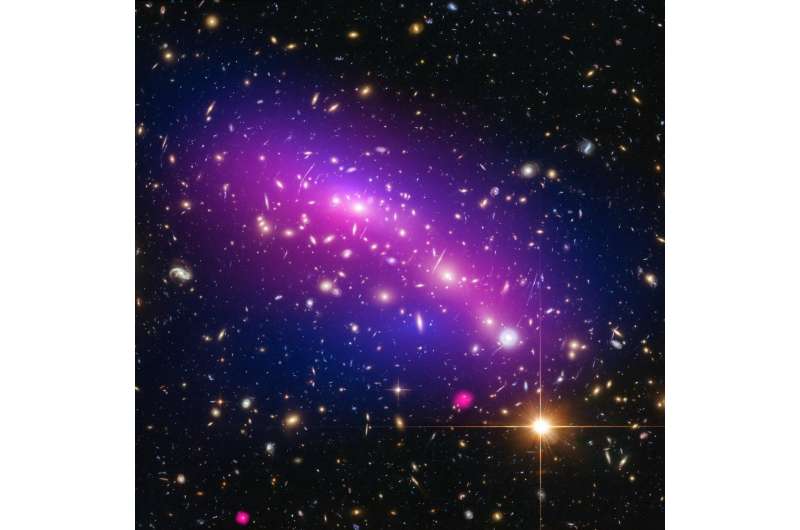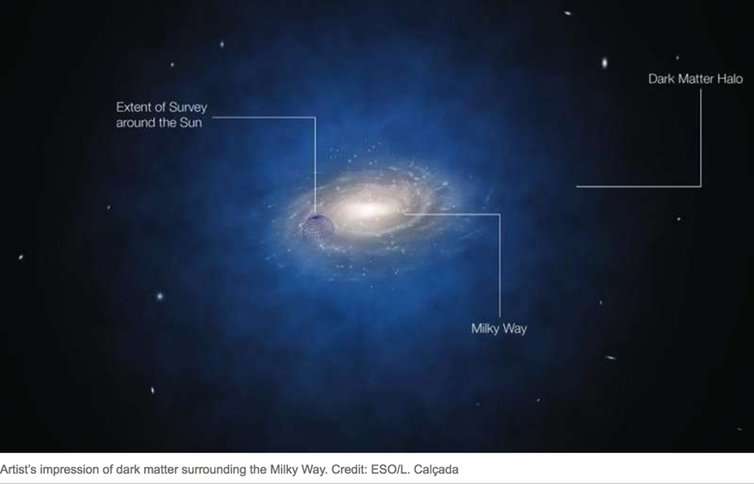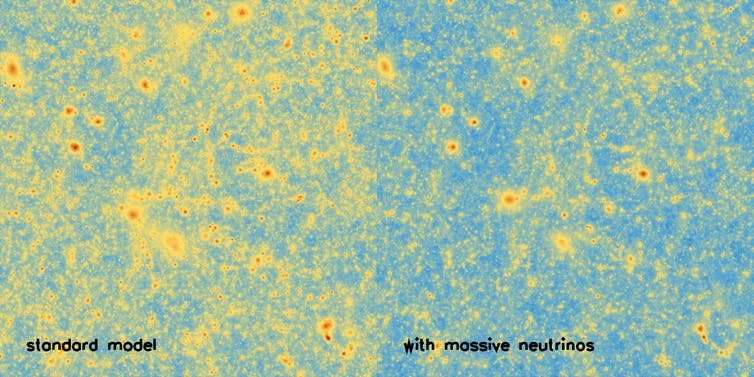Study suggests the elusive neutrino could make up a significant part of dark matter

Physicists trying to understand the fundamental structure of nature rely on consistent theoretical frameworks that can explain what we see and simultaneously make predictions that we can test. On the smallest scale of elementary particles, the standard model of particle physics provides the basis of our understanding.
On the scale of the cosmos, much of our understanding is based on "standard model of cosmology". Informed by Einstein's theory of general relativity, it posits that the most of the mass and energy in the universe is made up of mysterious, invisible substances known as dark matter (making up 80% of the matter in the universe) and dark energy.
Over the past few decades, this model has been remarkably successful at explaining a wide range of observations of our universe. Yet we still don't know what makes up dark matter – we only know it exists because of the gravitational pull it has on galaxy clusters and other structures. A number of particles have been proposed as candidates, but we can't say for sure which one or several particles make up dark matter.
Now our new study – which hints that extremely light particles called neutrinos are likely to make up some of the dark matter – challenges our current understanding of its composition.
Hot versus cold
The standard model holds that dark matter is "cold". That means it consists of relatively heavy particles that initially had sluggish motions. As a consequence, it is very easy for neighbouring particles to get together to form objects bound by gravity. The model therefore predicts that the universe should be filled with small dark matter "haloes", some of which will merge and form progressively more massive systems – making the cosmos "lumpy".

However, it is not impossible that at least some dark matter is "hot". This would comprise relatively light particles that have quite high velocities – meaning the particles could easily escape from dense regions such as galaxies. This would slow the accumulation of new matter and lead to a universe where the formation of structure is suppressed (less lumpy).
Neutrinos, which whizz around at extremely high velocities, are a good candidate for hot dark matter. In particular, they do not emit or absorb light – making them appear "dark". It was long assumed that neutrinos, which come in three different species, don't have mass. But experiments have demonstrated that they can change (oscillate) from one species to another. Importantly, scientists have shown that this changing requires them to have mass – making them a legitimate candidate for hot dark matter.
Over the past few decades, however, both particle physics experiments and various astrophysical lines of argument have ruled out neutrinos as making up most of the dark matter in the universe. What's more, the standard model assumes that neutrinos (and hot dark matter in general) have so little mass that their contribution to dark matter can be ignored completely (in most cases assumed to be 0%). And, until very recently, this model has reproduced a wide variety of cosmological observations quite well.
Changing picture
In the past few years, the quantity and quality of cosmological observations has shot up enormously. One of the most prominent examples of this has been the emergence of "gravitational lensing observations". General relativity tells us that matter curves spacetime so that light from distant galaxies can be deflected by massive objects that lie between us and the galaxies. Astronomers can measure such deflection to estimate the growth of structure (the "lumpiness") in the universe over cosmic time.
These new data sets have presented cosmologists with a number of ways to test in detail the predictions of the standard model. A picture that is beginning to emerge from these comparisons is that the mass distribution in the universe appears to be less lumpy than it ought to be if the dark matter is entirely cold.

However, making comparisons between the standard model and the new data sets may not be as straightforward as first thought. In particular, researchers have shown that the apparent lumpiness of the universe is not just affected by dark matter, but also by complex processes that affect normal matter (protons and neutrons). Previous comparisons assumed that normal matter, which "feels" both gravity and pressure forces, is distributed like dark matter, which only feels gravity.
Now our new study has produced the largest suite of cosmological computer simulations of normal and dark matter to date (called BAHAMAS). We have also made careful comparisons with a wide range of recent observations. We conclude that the discrepancy between the new observational data sets and the standard cold dark matter model is even larger than previously claimed.
We looked at the effects of neutrinos and their motions in great detail. As expected, when neutrinos were included in the model, the structure formation in the cosmos was washed out, making the universe less lumpy. Our results suggest that neutrinos make up between 3% and 5% of the total dark matter mass. This is sufficient to consistently reproduce a wide variety of observations – including the new gravitational lensing measurements. If a larger fraction of the dark matter is "hot", the growth of structure in the universe is suppressed too much.
The research may also help us solve the mystery of what the mass of an individual neutrino is. From various experiments, particle physicists have calculated that the the sum of the three neutrino species should be at least 0.06 electron Volts (a unit of energy, similar to joules). You can convert this into an estimate of the total neutrino contribution to dark matter, and it works out to be 0.5%. Given that we have found it is actually six to ten times larger than this, we can deduce that the neutrino mass should be about 0.3-0.5 eV instead.
This is tantalisingly close to values that can actually be measured by upcoming particle physics experiments. If these measurements corroborate the masses we found in our simulations, this would be very reassuring – giving us a consistent picture of the role of neutrinos as dark matter from the largest cosmological scales to the tiniest particle physics realm.
Provided by The Conversation
This article was originally published on The Conversation. Read the original article.![]()




















